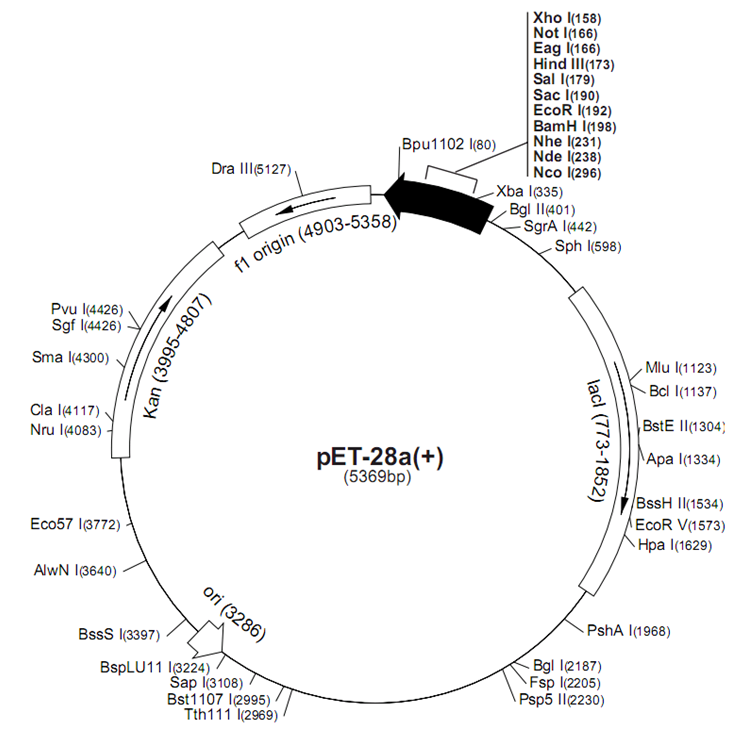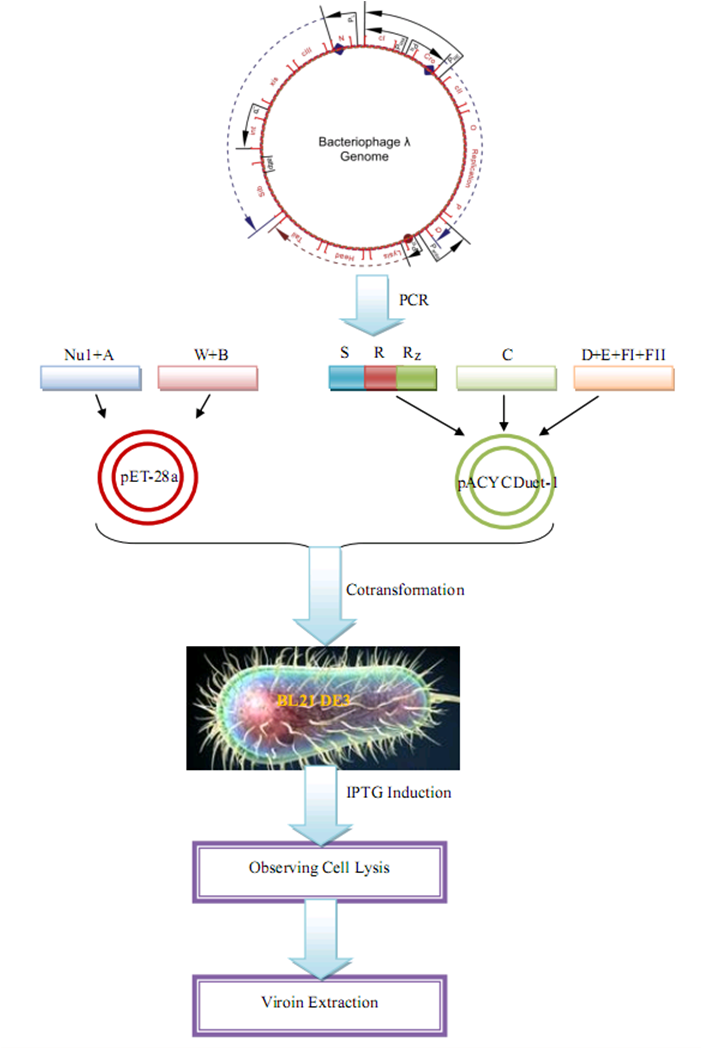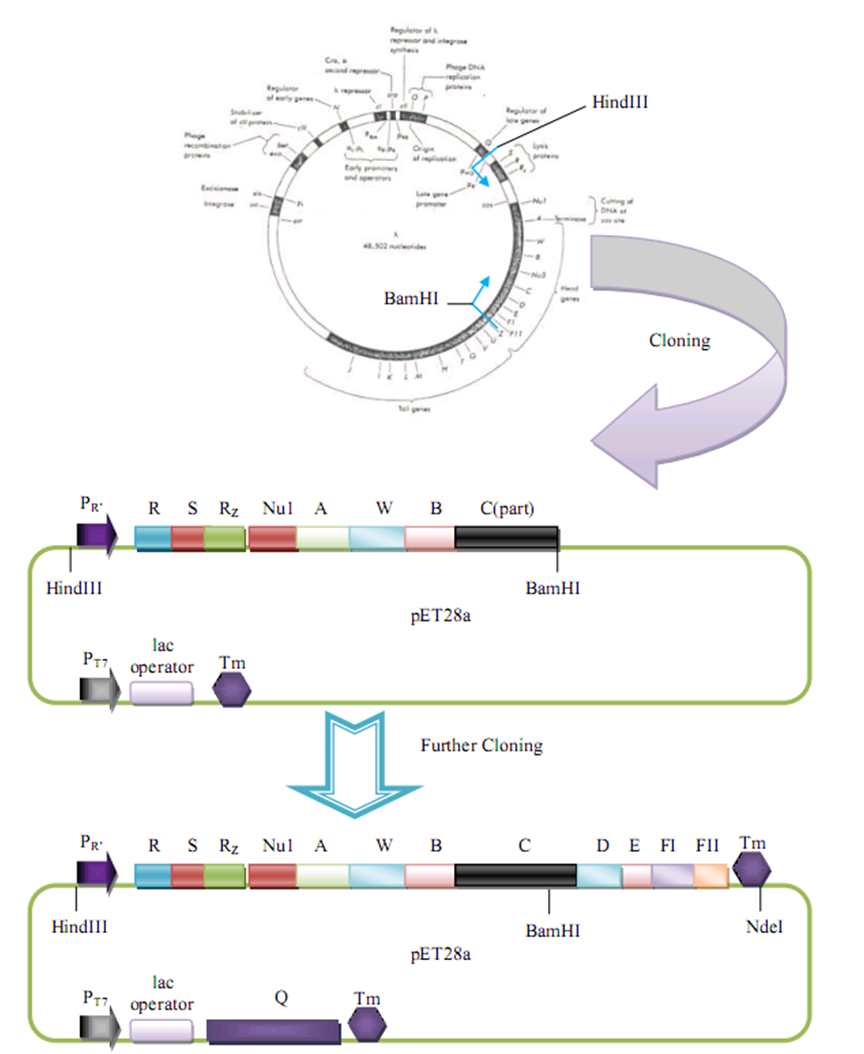Team:Tsinghua/Experiment1
From 2009.igem.org
GuoQiangChen (Talk | contribs) |
|||
| Line 8: | Line 8: | ||
[[Image:pACYCDuet1.jpg|450px|pACYCDuet1]] | [[Image:pACYCDuet1.jpg|450px|pACYCDuet1]] | ||
| - | We incorporate the segment from Nu1 to B on bacteriophage lambda genome into pET-28a while clone the left segment from C to FII (C will be further engineered) into pACYCDuet-1. Before | + | We incorporate the segment from Nu1 to B on bacteriophage lambda genome into pET-28a while clone the left segment from C to FII (C will be further engineered) into pACYCDuet-1. Before co-transformation with therapeutic DNA, we firstly co-transform the two plasmids encoding the GenSniper genome into BL21 DE3 and evaluate their function. |
[[Image:BUA001.jpg|700px|center|BUA001]] | [[Image:BUA001.jpg|700px|center|BUA001]] | ||
==Top-Down Approach== | ==Top-Down Approach== | ||
| - | In the top-down approach, the part of needed segment on the lambda genome will be firstly | + | In the top-down approach, the part of needed segment on the lambda genome will be firstly cut by restriction enzyme B''am''HI and H''ind''III and then incorporated into pET-28a. The lefted segment will be further integrated downstream of the primary clone. Additionally, an expression module for Q protein will be constructed for induction of the expression of the GenSniper genome. |
[[Image:TDA001.jpg|800px|center|TDA001]] | [[Image:TDA001.jpg|800px|center|TDA001]] | ||
=GenSniper Production Evaluation= | =GenSniper Production Evaluation= | ||
| - | Firstly, we will spread the | + | Firstly, we will spread the co-transformed BL21 DE3 E.coli strains onto Kan-Cm double antibiotics plate to test their compatibility. |
| - | Secondly, we will measure the OD changes of the | + | Secondly, we will measure the OD changes of the co-transformed E.coli strains to evaluate the function of lysis genes. |
| - | Thirdly, we will perform the | + | Thirdly, we will perform the virion isolation procedure on our lysed cell culture. Then electronic microscopy will be applied to observe the package of the GenSniper virion. |
[[Image:Evaluation.jpg|800px|center|thumb|Experiment Design for GenSniper Production Evaluation]] | [[Image:Evaluation.jpg|800px|center|thumb|Experiment Design for GenSniper Production Evaluation]] | ||
Revision as of 04:17, 21 October 2009
Contents |
Synthesis of the Genome of GenSniper
Bottom-Up Approach
In the bottom-up approach, we amplify the biobricks from both the bacteriophage lambda and the adenovirus genome and incorporate them with a given order into molecular cloning vector(s).
Specifically, we choose two molecular cloning vectors to encode two sections of the gene therapy vector genome, pET-28a and pACYCDuet-1.
We incorporate the segment from Nu1 to B on bacteriophage lambda genome into pET-28a while clone the left segment from C to FII (C will be further engineered) into pACYCDuet-1. Before co-transformation with therapeutic DNA, we firstly co-transform the two plasmids encoding the GenSniper genome into BL21 DE3 and evaluate their function.
Top-Down Approach
In the top-down approach, the part of needed segment on the lambda genome will be firstly cut by restriction enzyme BamHI and HindIII and then incorporated into pET-28a. The lefted segment will be further integrated downstream of the primary clone. Additionally, an expression module for Q protein will be constructed for induction of the expression of the GenSniper genome.
GenSniper Production Evaluation
Firstly, we will spread the co-transformed BL21 DE3 E.coli strains onto Kan-Cm double antibiotics plate to test their compatibility.
Secondly, we will measure the OD changes of the co-transformed E.coli strains to evaluate the function of lysis genes.
Thirdly, we will perform the virion isolation procedure on our lysed cell culture. Then electronic microscopy will be applied to observe the package of the GenSniper virion.
 "
"




